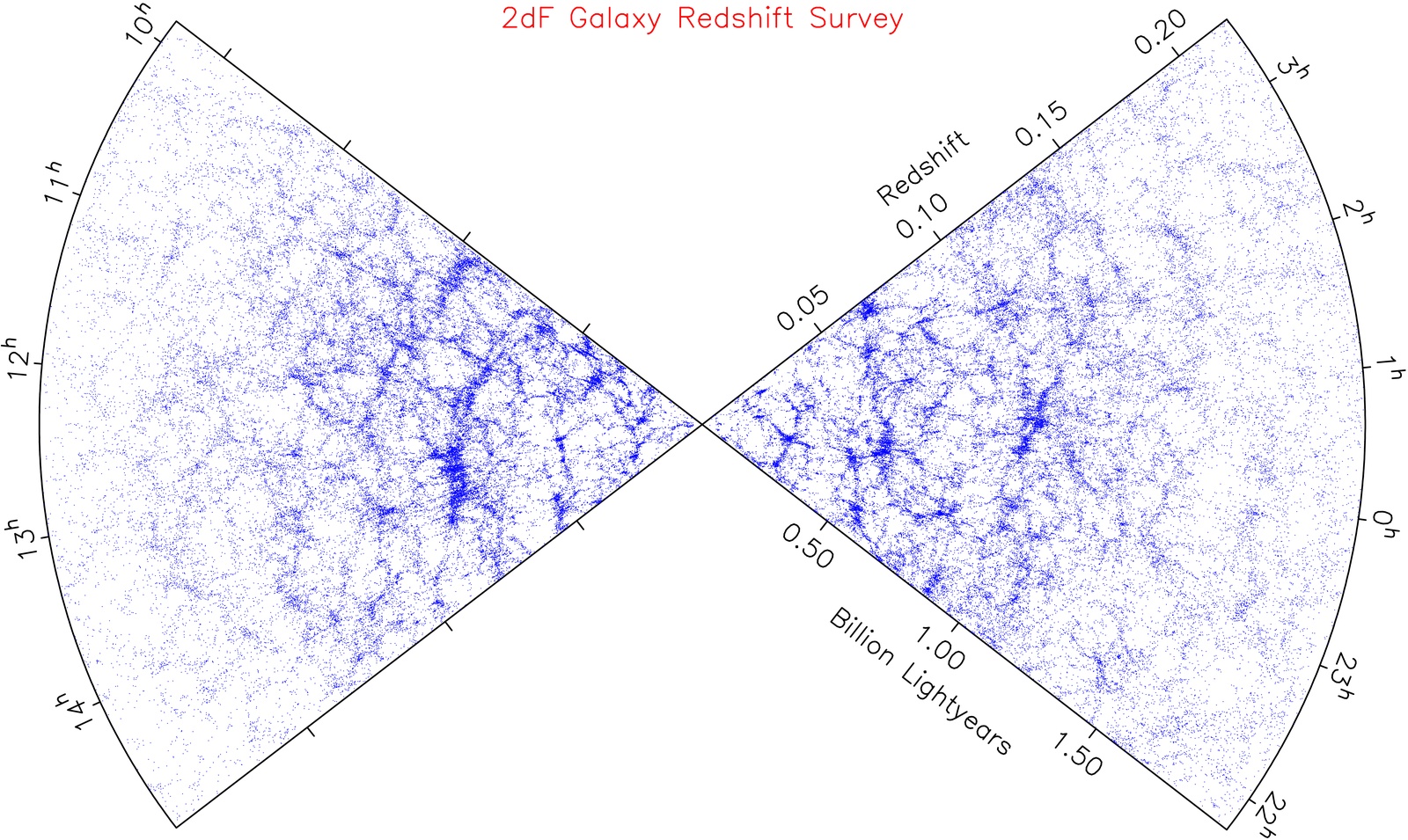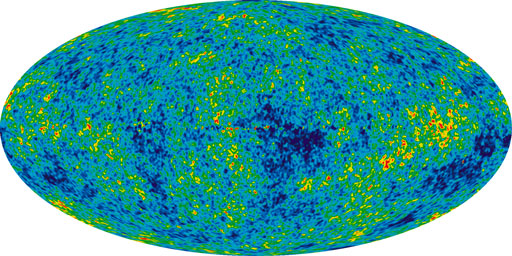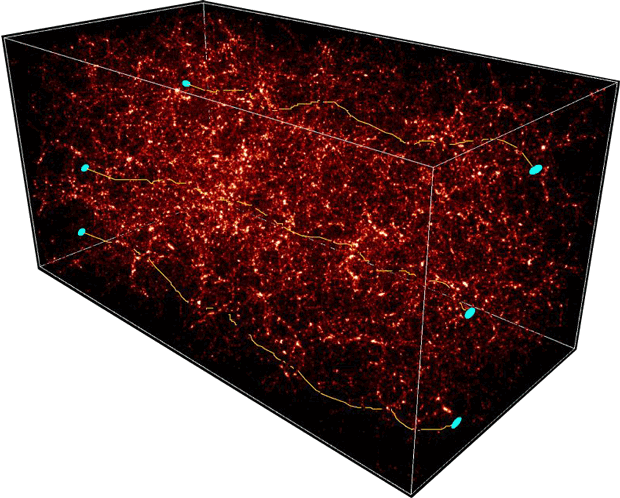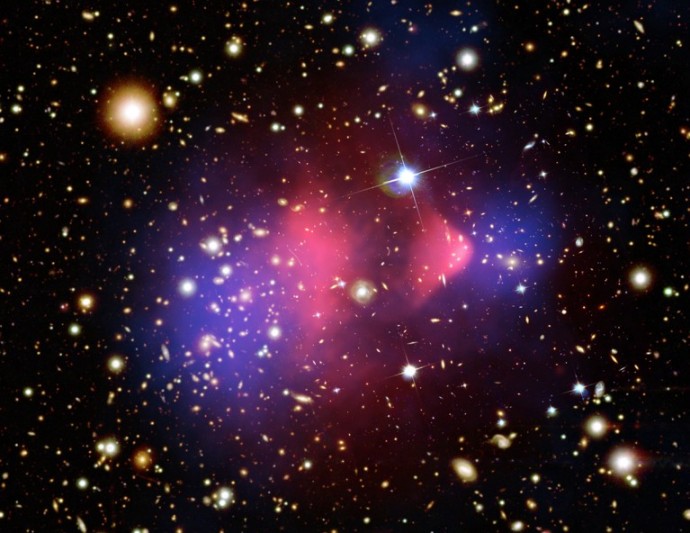Overview
My scientific work focuses on contemporary questions in cosmology and galaxys physics. I am particularly interested in exploring the following:
-
Cosmological parameters, which quantify the average mixture of different forms of matter and energy in the Universe;
-
The past rate of space expansion between galaxies;
-
The large-scale distribution of matter (including dark matter), particularly how it is arranged between and around galaxies;
-
The statistical difference between the spatial densities of matter and galaxies, known as galaxy bias.
My primary observational tool for investigating these topics is the weak gravitational-lensing effect, a relatively new and exciting method that has only become viable in the last twenty years.
The general picture
The standard cosmological model, known as Lambda-CDM (a cold dark matter model with cosmological constant Lambda) or just 'LCDM', is still the favoured model among cosmologists due to its success in explaining a wide range of observations. This model posits a Universe that began as a simple, hot, and homogeneous state about 13.8 billion years ago. Over time, it evolved into the structured, colder Universe we see today. The model explains the global expansion of the cosmos -- including its recent acceleration -- and the formation of structures like stars and galaxies as a natural consequence of gravitational attraction. The larger distribution of galaxies, the signposts for cosmologists, reflects the large-scale distribution of matter.
In more detail, the LCDM model quantitatively describes the emergence of chemical elements and the growth of structure. This process began with minute fluctuations in the early matter density that collapsed due to gravity, all within an expanding space as described by Einstein's theory of general relativity. In this context, "expanding" means the average density and temperature decrease, not necessarily that the volume increases. Similarly, the Big Bang did not occur in a specific location but happened everywhere at once. For this model to be accurate, the Universe's matter composition must be primarily dark matter. In contrast, ordinary visible baryonic matter -- the building blocks of stars and planets -- makes up only a small fraction. We infer the existence of the persistently illusive dark matter indirectly from its gravitational effects on the propagation of light and the motion and distribution of visible matter.
A direct detection of dark matter is considered challenging because it appears to be only weakly interacting. So far, no strong evidence for its direct detection has been found. To physicists, however, weakly interacting particles are not that unusual: the well-studied neutrinos in the standard model of physics interact only through the weak force and gravity. They, too, cannot be "seen" because they do not interact with light. Unfortunately, dark matter cannot simply be entirely neutrinos because neutrinos are too light and diffuse to explain the large-scale distribution of galaxies we observe.

The hot, homogeneous beginnings of the Universe are still observable today through the cosmic microwave background (CMB). This radio radiation, observed with a consistent spectrum across the entire sky, has a perfect thermal spectrum corresponding to a temperature of about 3 K. This was a direct prediction of the Hot Big Bang theory from the 1940s, accidentally discovered by Penzias and Wilson until some 30 years later. Another key prediction of the Hot Big Bang model is the relative abundance of light elements in the early Universe, which perfectly matches observations: roughly 75% of the baryonic mass in the Universe is hydrogen, with nearly all the rest being helium. Traces of atoms heavier than lithium must have been formed later, either through nuclear fusion in the cores of stars or, as discovered more recently, by colliding neutron stars.

Credit: NASA and the WMAP team
On closer inspection of the CMB, tiny angular fluctuations in temperature, on the order of 0.00001 degrees Celsius, can be seen. These fluctuations reflect small variations in matter density from about 300 000 years after the Big Bang, when the Universe became cool enough to be transparent to electromagnetic radiation. The LCDM model successfully links these fluctuations -- specifically their size dependence -- to the distribution of matter and galaxies we observe today. Furthermore, it consistently connects the frequency spectrum of the CMB fluctuations to the observable expansion history of the Universe.
The LCDM model also quantitatively describes the gravitational deflection of light from distant galaxies by intervening matter. This phenomenon is known as gravitational lensing. It is a relatively new field of science that uses this light-deflection effect to probe the gravitational field produced primarily by dark matter. The physical nature of the lensing matter is irrelevant; if it has mass, it exerts a gravitational pull and deflects light rays. This makes it a unique and powerful tool for cosmologists. Over the last decade, gravitational lensing has matured significantly, allowing scientists to achieve several milestones:
-
Directly mapping the distribution of dark matter;
-
Studying the matter density profiles of galaxy clusters and determining their mass;
-
Measuring the mismatch between galaxy and matter distributions for different galaxy populations;
-
Measuring the mean large-scale matter density and the amplitude of its fluctuations over time.
Gravitational lensing has been used to confirm the accelerated expansion of the cosmos. This finding is consistent with what is observed in CMB studies, Type Ia supernovae, and baryonic acoustic oscillations in the galaxy distribution.
Recently, in 2025, evidence has emerged from a combination of different cosmological probes suggesting that the Universe's expansion rate may not be perfectly consistent with a constant cosmological constant, a key component of the standard LCDM model. This could mark the beginning of a refinement of the cosmological standard model if confirmed. Other evidence might come from observations of the very first galaxies that formed shortly after the CMB.

An important discovery made using gravitational lensing concerns the famous Bullet Cluster. This cluster is the remnant of a collision between two large galaxy clusters. In this cosmic accident, the collisionless, this means interaction-free, matter of the clusters (depicted in blue in the image below) was separated from the baryonic content. The baryonic content, visible as hot gas emitting X-rays (shown in red), was left behind in the collision's wake. This separation provides strong evidence that cluster galaxies are gravitationally held together by a collisionless form of matter, which cannot be atoms or molecules. The analysis of the gravitational lensing signal shows that almost all the mass in this system is still associated with the galaxies (blue), while the mass of the gas (red) is negligible in comparison. This observation demonstrates that the matter gluing galaxies together in a cluster must be (virtually) collisionless -- precisely the attributes we have to postulate for dark matter.

Credit: M. Markevitch et al. (X-ray) & D. Clowe et al. (optical; lensing map)
Gravitational lensing is also an excellent tool for studying galaxy physics. Galaxies are believed to have formed within the gravitational potential wells of dark matter, where baryonic matter is drawn in, cools, and forms stars. We refer to these dark matter concentrations as dark matter haloes. As the Universe is evolving, these haloes and the galaxies within them merge to form increasingly larger haloes. While the evolution of dark matter haloes is well-understood within the LCDM framework, the formation and evolution of galaxies are notoriously difficult to predict due to complex baryonic physics. Therefore, a crucial test for the LCDM model is whether it can successfully explain the wide variety of observed galaxy properties at different periods of the cosmic evolution.
To make progress, theorists will need to refine their models of galaxy physics in the coming years, while observers will have to gather more data on the connection between galaxies and dark matter.
Gravitational lensing will undoubtedly be a key player in this effort.